Math? To plan dinner? Isn’t there a better way? Yes there is. Just take a look at your hand. Use your fist, palm, cupped hand, and thumb to practice calorie control – while avoiding the hassle of counting calories.
- Want to see our visual guide? Check out the infographic here…
- Want to listen instead of read? Download the audio recording here…
++
If you’ve heard it once, you’ve heard it a thousand times: The best — maybe even the only — way to lose weight is to count calories.
After all, it’s a pretty simple equation: Calories in vs. calories out. Eat more calories than you burn, and you gain weight. Eat fewer calories than you burn and you lose weight.
Except counting calories isn’t that simple.
- Want to listen instead of read? Download the audio recording here…
The problems with calorie counting
First of all — on the “calories in” side — you do need to figure out how many calories are in the foods you want to eat. And that takes handbooks, websites, databases and math. Just to plan your lunch. Groan.
Next, you have to assume that the handbooks, websites, and databases’ calorie estimates are correct. They’re often not. In fact, research has shown they can be off by about 25% because of incorrect labeling, laboratory measurement error, and food quality.
Then, of course, there’s the “calories out” side. Estimating your calorie expenditure each day comes with another 25% measurement error because of the equipment you’re using, laboratory measurement errors, and individual differences.
A possible 25% error on the “calories in” side, and another 25% error on the “calories out” side.
Is it even worth:
- pulling out measuring cups to a chorus of boos from family members;
- dusting off the food scale while trying to ignore the taunts of friends;
- wheeling in the abacus from the den to keep up the calorie tally;
- subscribing to apps and web services to track these less-than-accurate numbers?
Sure, we should have an idea of how much food we’re eating each day, so we can adjust based on our goals.
But counting calories itself is a drag! No wonder so many people give up and go back to eating the way they were before.
The calorie counting antidote
Here’s the good news: counting calories is rarely necessary.
Our Precision Nutrition coaching programs gauge food portions differently. No carrying around weigh-scales and measuring cups. No calculators or smart phones.
All you need is the ability to count to two. And your own hand.
Here how it works:
- Your palm determines your protein portions.
- Your fist determines your veggie portions.
- Your cupped hand determines your carb portions.
- Your thumb determines your fat portions.
To determine your protein intake
For protein-dense foods like meat, fish, eggs, dairy, or beans, use a palm sized serving.
For men we recommend two palm-sized portions with each meal.
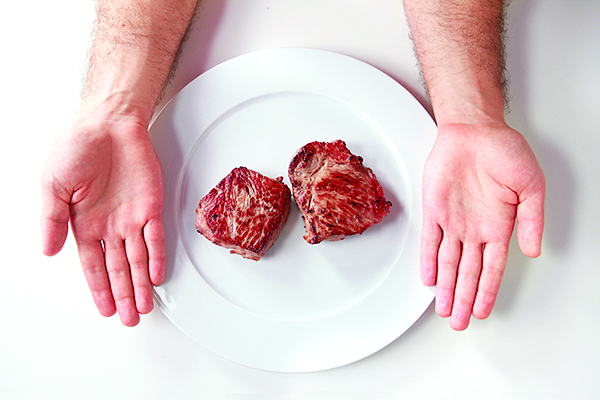
And for women we recommend one palm-sized portion with each meal.
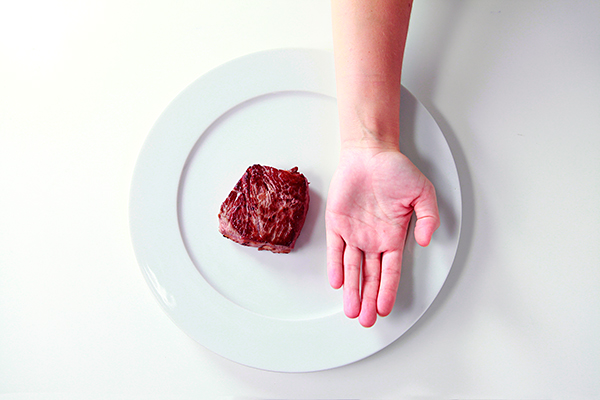
Note: a palm-sized portion is the same thickness and diameter as your palm.
To determine your vegetable intake
For veggies like broccoli, spinach, salad, carrots, etc. use a fist-sized serving.
For men we recommend 2 fist-sized portions of vegetables with each meal.
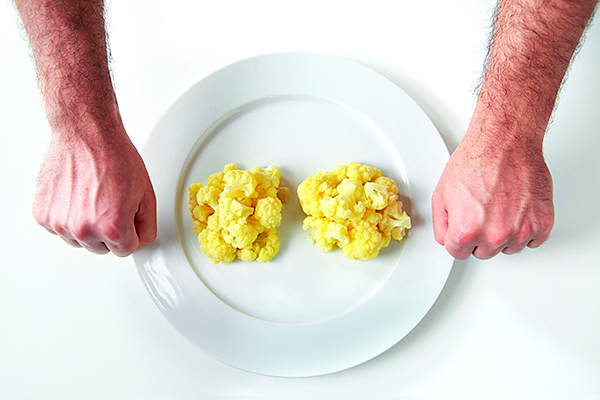
And for women we recommend 1 fist-sized portion of vegetables with each meal.
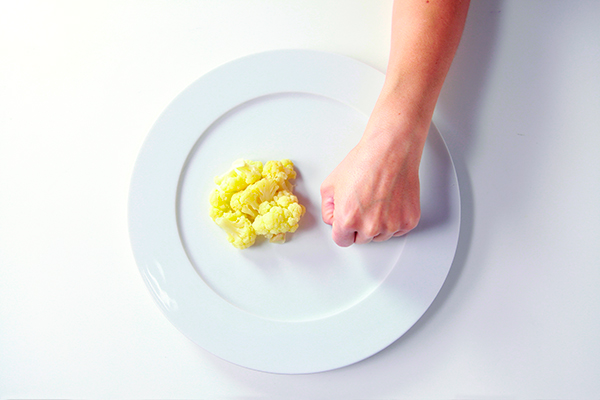
Again, a fist-sized portion is the same thickness and diameter as your fist.
To determine your carbohydrate intake
For carbohydrate-dense foods – like grains, starches, or fruits – use a cupped hand to determine your serving size.
For men we recommend 2 cupped-hand sized portions of carbohydrates with most meals.
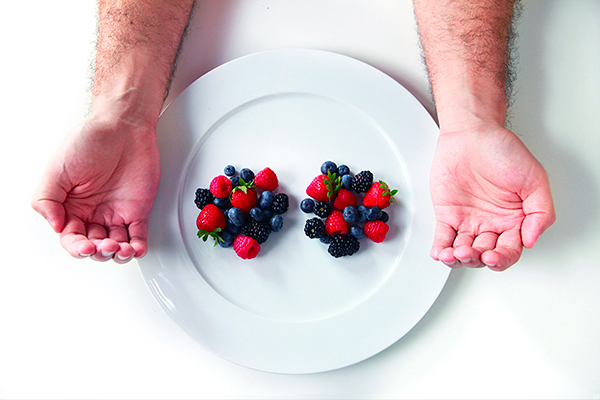
And for women we recommend 1 cupped-hand sized portion of carbohydrates with most meals.
To determine your fat intake
For fat-dense foods – like oils, butters, nut butters, nuts/seeds – use your entire thumb to determine your serving size.
For men we recommend 2 thumb-sized portions of fats with most meals.

And for women we recommend 1 thumb-sized portion of fats with most meals.
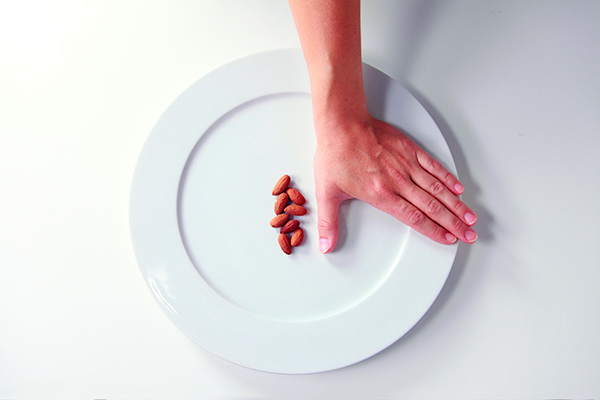
A note on body size
Of course, if you’re a bigger person, you probably have a bigger hand. And if you’re a smaller person… well, you get the idea. Your own hand is a personalized (and portable) measuring device for your food intake.
True, some people do have larger or smaller hands for their body size. Still, our hand size correlates pretty closely with general body size, including muscle, bone – the whole package.
Planning your meals flexibly
Based on the guidelines above, which assume you’ll be eating about 4 times a day, you now have a simple and flexible guide for meal planning.
For men:
- 2 palms of protein dense foods with each meal;
- 2 fists of vegetables with each meal;
- 2 cupped hands of carb dense foods with most meals;
- 2 entire thumbs of fat dense foods with most meals.
For women:
- 1 palm of protein dense foods with each meal;
- 1 fist of vegetables with each meal;
- 1 cupped hand of carb dense foods with most meals;
- 1 entire thumb of fat dense foods with most meals.
Of course, just like any other form of nutrition planning — including calorie counting – this serves as a starting point.
You can’t know exactly how your body will respond in advance. So stay flexible and adjust your portions based on your hunger, fullness, and other important goals.
For example: if you’re trying to gain weight, and you’re having trouble gaining, you might add another cupped palm of carbohydrates or another thumb of fats. Likewise, if you’re trying to lose weight but seem to have stalled out, you might eliminate a cupped palm of carbohydrates or a thumb of fats at particular meals.
Remember: This is a starting point. Adjust your portions at any time using outcome-based decision making, aka “How’s that working for you?”
Want more individualization?
For those who want to go further – because they have more advanced goals or because they’re already eating well but still struggling – let’s dig a little deeper.
At Precision Nutrition, we have a really simple shortcut for helping people “eat right for their goals”.
We begin by classifying clients into one of three general categories (or somatotypes):
- I types (ectomorphs),
- V types (mesomorphs), and
- O types (endomorphs).
And each type gets slightly different recommendations.
For more about this approach, click here: How to fix a broken diet: 3 ways for getting your eating on track.
For fitness and nutrition professionals
As a fitness or nutrition coach, you might have certain food/nutrient goals in mind for your clients. No problem.
But should you tell them to eat 1 g of protein per pound of body weight? Or 25-50 grams of protein with lunch? (Hint: No.)
Many clients don’t even know which foods have protein in them, let alone knowing how many grams each food has and what a portion size of that food looks like. That makes gram-based recommendation pretty tricky.
Fussing with numbers creates a lot of anxiety and confusion for clients. Eating healthy will seem “just too complicated” for them, and they’ll eventually give up or wander off in the wrong direction.
Plus, here’s the most important piece: Most clients don’t need this level of detail. The simpler and clearer you can make your recommendations, the more likely clients are to follow them.
So, instead, why not share these guidelines? How much easier can healthy, individualized eating be?
Download our calorie control guide
To make this even easier, we created a simple guide for men and women that summarizes our recommendations. Click here to download it, print it out, and share them with friends, family, or clients.

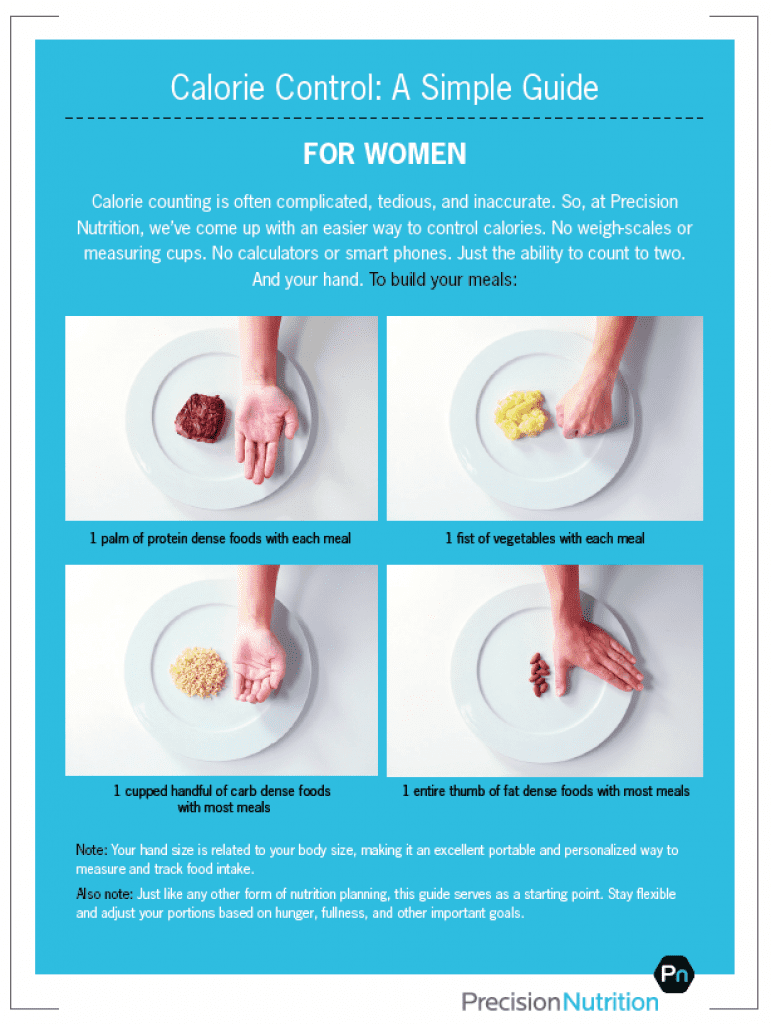
In the end, if you’d like to start eating better, just take a look at your hand. Use your fist, palm, cupped hand, and thumb to practice calorie control – while avoiding the hassle of counting calories.
If you’re a coach, or you want to be…
You can help people build sustainable nutrition and lifestyle habits that will significantly improve their physical and mental health—while you make a great living doing what you love. We'll show you how.
If you’d like to learn more, consider the PN Level 1 Nutrition Coaching Certification. (You can enroll now at a big discount.)


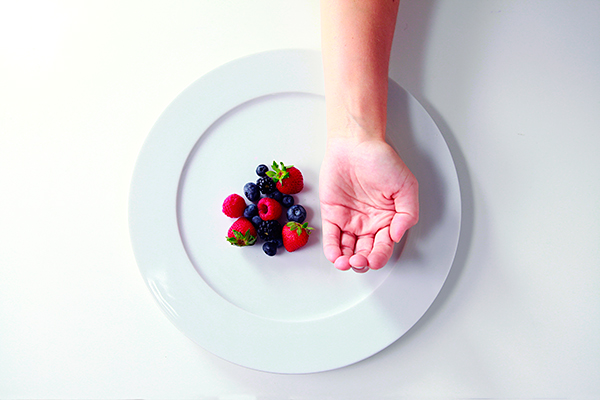
Share